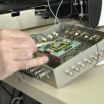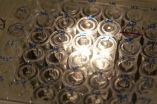(Press-News.org) November 10, 2010 -- To keep soldiers in the battlefield healthy, the U.S. Army is exploring new ways to detect harmful bacteria in water.
Current techniques for analyzing water in the field can take as long as 24 hours to complete, according to Bart Lipkens of Western New England College in Springfield, Massachusetts and his colleagues at Physical Sciences in Andover, Ma.
They are working on an alternative technology that uses sound waves to accelerate the process.
"The goal of our project is to speed up the detection of bacteria in water supplies," said Lipkens. "We're developing a first order trigger, an alarm that maybe there's something in the water that warrants further investigation."
Lipkens has created a device that quickly gathers bacterial spores from running water using acoustical radiation force. It broadcasts waves of ultrasound into the liquid, exerting a pressure on the bacteria that pushes it into a collection pocket. In previous work, Lipkens used this technique to successfully separate polystyrene beads from water.
The device can draw in 15 percent of the bacterial cells from the water in a single pass. When the flow is shut off, the bacteria settle and can then be transferred to another apparatus for identification. Compared to existing methods, this procedure is quick.
Bacillus cereus, the species of bacteria used in this experiment, is about a micron in diameter and harmless. But its properties are very similar to many types of bacteria that would be harmful in drinking water.
"We think we would ultimately get the same results with harmful bacteria," said Lipkens, who will present his data at the 2nd Pan-American/Iberian Meeting on Acoustics in Cancun, Mexico.
###
The talk "Separation of bacterial spores from flowing water in macroscale cavities by ultrasonic standing waves" by Bart Lipkens will be presented at 4:45 p.m. on Tuesday, November 16.
MORE INFORMATION ABOUT THE 2ND PAN-AMERICAN/IBERIAN MEETING ON ACOUSTICS
The 2nd Pan-American/Iberian Meeting on Acoustics takes place at the Fiesta Americana Grand Coral Beach Hotel in Cancun, Mexico, Monday through Friday, November 15-19, 2010. The Fiesta Americana Grand Coral Beach Hotel is located at Blvd. Kukulcán km. 9.5, Cancún Hotel Zone, Cancún, Q.R., 77500. The hotel's main numbers are +52 (998) 881 32 00 and, toll-free, 1-888-830-9008.
USEFUL LINKS
Main meeting website: http://asa.aip.org/cancun/cancun.html
Full meeting program: http://asa.aip.org/cancun/program.html
Searchable index: http://asa.aip.org/asasearch.html
Hotel site:
http://www.fiestamericanagrand.com/portal/p/es_MX/FAG/FCB/1/0/Availability/showMinisitioM2.do?showContenido=/descripcionhotel/FCBdescripcionhotel_M2.html&idioma=en_MX
WORLD WIDE PRESS ROOM
ASA's World Wide Press Room (www.acoustics.org/press) contains tips on dozens of newsworthy stories and with lay-language papers, which are 300-1200 word summaries of presentations written by scientists for a general audience and accompanied by photos, audio and video.
PRESS REGISTRATION
We will grant free registration to credentialed full-time journalists and professional freelance journalists working on assignment for major news outlets. If you are a reporter and would like to attend, please contact Jason Bardi (jbardi@aip.org, 301-209-3091), who can also help with setting up interviews and obtaining images, sound clips, or background information.
ABOUT THE ACOUSTICAL SOCIETY OF AMERICA
The Acoustical Society of America (ASA) is the premier international scientific society in acoustics devoted to the science and technology of sound. Its 7,500 members worldwide represent a broad spectrum of the study of acoustics. ASA publications include The Journal of the Acoustical Society of America -- the world's leading journal on acoustics -- Acoustics Today magazine, books, and standards on acoustics. The society also holds two major scientific meetings each year. For more information about ASA, visit our website at: http://asa.aip.org
END
The eye is not just a lens that takes pictures and converts them into electrical signals. As with all vertebrates, nerve cells in the human eye separate an image into different image channels once it has been projected onto the retina. This pre-sorted information is then transmitted to the brain as parallel image sequences. Scientists from the Max Planck Institute of Neurobiology in Martinsried have now discovered that fruit flies process optical information in a similar way. The evidence suggests that this type of wiring is an effective energy-saving mechanism and is therefore ...
Dogs have long been called man's best bomb detector –– until now.
A Tel Aviv University scientist leads a research team that has developed a powerful electronic sensor to detect multiple kinds of explosives –– including those used in the recent Yemeni bomb threat. Based on nanotechnology advances, the new sensor is small, portable, and is more sensitive and reliable at detecting explosives than any sniffer dog, says its lead researcher Prof. Fernando Patolsky of Tel Aviv University's Raymond and Beverly Sackler School of Chemistry.
With scientific findings on it published ...
CHAMPAIGN, Ill. — The Chrysler and General Motors bankruptcy reorganizations represented a sea change in corporate restructuring, one that could portend the end of our current system of bankruptcy reorganization, according to a published article by two University of Illinois experts in bankruptcy law.
Law professors Charles J. Tabb and Ralph Brubaker argue that the legal principles applied in the GM and Chrysler bankruptcies – two of the largest in U.S. history at $83.5 and $39.9 billion, respectively – were misguided, and ultimately have undermined the distributional ...
Manufacturer recalls of toys, promotional drinking glasses, and other children's products constitute an ongoing "toxic toys crisis" that requires banning potentially harmful ingredients in these products and other changes in policy and practices. That's the conclusion of a new analysis in ACS' Environmental Science & Technology, a semi-monthly journal.
Monica Becker, Sally Edwards and Rachel Massey note that in June the United States government recalled 12 million promotional drinking glasses sold at a fast-food restaurant chain because the painted coating contained ...
Snap an image of friends in front of a window curtain and the camera captures the people - and invisible blood stains splattered on the curtain during a murder. Sound unlikely? Chemists from the University of South Carolina are reporting development of a camera with that ability to see the invisible, and more. Called multimode imaging in the thermal infrared, the new technology could find uses in crime scene investigations and elsewhere, they say in a series of three reports in ACS' Analytical Chemistry, a semi-monthly journal.
Michael Myrick, Stephen Morgan and their ...
Scientists have observed, for the first time, an intermediate stage in the chemical process that repairs DNA methylation damage and regulates many important biological functions that impact health conditions such as obesity, cancer and diabetes.
The observations focused on the bacterial DNA repair protein AlkB, but the results also apply to several proteins in the same family that play key regulatory roles in humans. Armed with these results, researchers may one day develop methods for blocking the protein's efforts to perform the biologically important demethylation ...
Scientists are reporting development of a long-sought method with the potential for getting medication through a biological barrier that surrounds the brain, where it may limit the brain damage caused by stroke. Their approach for sneaking the nerve-protective drug erythropoietin into the brain is medicine's version of the Trojan Horse ploy straight out of ancient Greek legend. It also could help people with traumatic head injuries, Parkinson's disease, and other chronic brain disorders. Their report appears in ACS' Molecular Pharmaceutics, a bi-monthly journal.
William ...
Experiments with an artificial stomach suggest that a popular lemon-lime soft drink could play an unexpected role in improving the effectiveness of an oral anticancer drug. The experiments produced evidence that patients will absorb more of the unnamed drug, tested in Phase I in clinical trials, when taken with "flat" or degassed Sprite. The study appears in ACS' Molecular Pharmaceutics, a bi-monthly journal.
Faraj Atassi and colleagues note that efforts are underway to develop more anticancer medications that patients can take by mouth. However, biological variations ...
Michael Mengel, a pathology researcher with the Faculty of Medicine & Dentistry, has found a new way to analyze biopsies from heart transplant patients by looking at their genes. This allows him to make an early prediction whether the transplant is working.
This is extremely important in heart transplant patients because a successful outcome depends completely on doing a biopsy of the heart tissue and prescribing treatments if necessary. In other organs transplants, doctors can use other measurements.
It's hoped the new technology and process developed in the Faculty ...
The seeds that you plant in your backyard garden next spring — and farmers sow in their fields — may have a guardian angel that helps them sprout, stay healthy, and grow to yield bountiful harvests. It's a thin coating of chemicals termed a "seed treatment" that can encourage seeds to germinate earlier in the season, resist insects and diseases, and convey other advantages. These new seed defenders are the topic of an article in the current issue of Chemical & Engineering News (C&EN), ACS' weekly newsmagazine.
C&EN Senior Business Editor Melody Voith describes a boom ...



